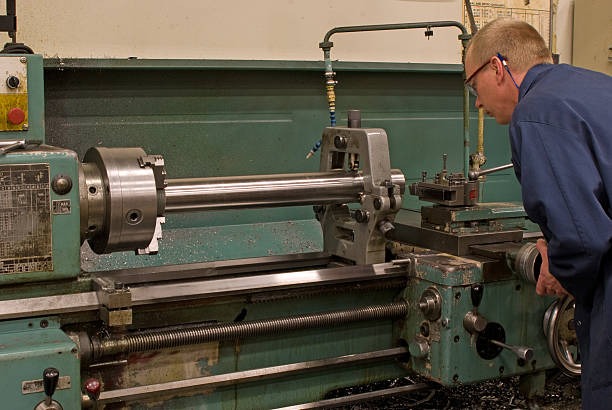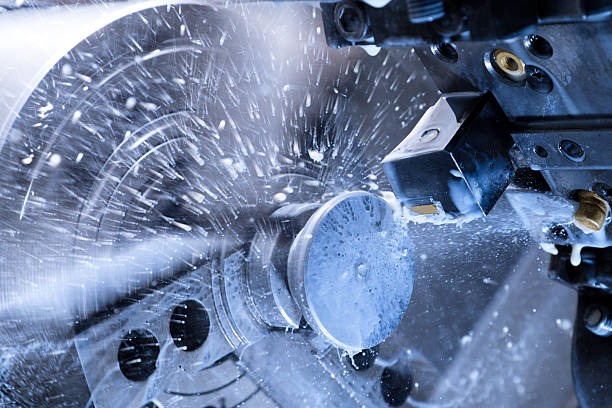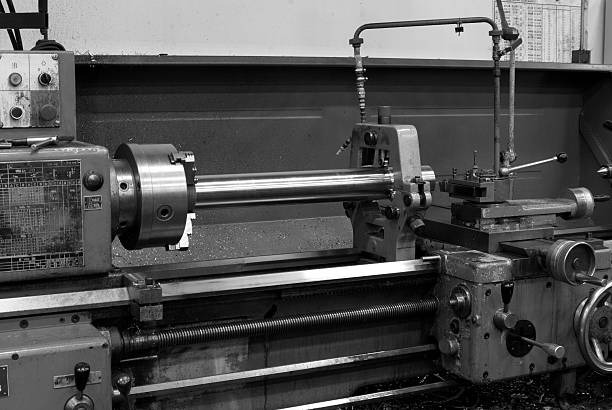คุณเคยเห็นชิ้นส่วนโลหะหยาบหมุนไปมาบนเครื่องกลึงหรือไม่ จากนั้นจึงถูกกลึงออกมาเป็นชิ้นส่วนที่มีความเงางามและแม่นยำสูงภายในเวลาเพียงไม่กี่นาที นี่คือตัวอย่างที่กระตุ้นความอยากรู้และชื่นชมการทำงานของเครื่องจักร ตั้งแต่อดีตอันไกลโพ้น เครื่องกลึงได้ขับเคลื่อนกระดูกสันหลังของความคิดสร้างสรรค์ไปข้างหน้า และในปัจจุบัน เครื่องกลึงยังคงกำหนดอุตสาหกรรมต่างๆ ในร้านซ่อมเล็กๆ และโรงงานอวกาศขนาดใหญ่ คุณจะพบเครื่องกลึงที่หมุนช้าๆ และแกะสลัก อย่างไรก็ตาม เครื่องกลึงทั้งหมดไม่ได้ทำงานหรือดูเหมือนกัน
แต่ละประเภทจะตอบสนองความต้องการที่แตกต่างกัน และการเลือกประเภทที่เหมาะสมอาจส่งผลให้ผลผลิตเพิ่มขึ้น ลดของเสีย และเกิดแนวคิดสำหรับผลิตภัณฑ์ใหม่ เราจะมาดูเครื่องกลึงแต่ละประเภทที่สำคัญ ทำความรู้จักกับส่วนประกอบของเครื่องกลึงแต่ละประเภท เปรียบเทียบแต่ละประเภท และเรียนรู้เคล็ดลับต่างๆ ที่คุณสามารถใช้ได้เมื่อต้องการเลือกเครื่องจักรที่เหมาะสมที่สุดสำหรับเวิร์กช็อปของคุณ เตรียมตัวให้พร้อม แล้วคุณจะเป็นผู้เชี่ยวชาญด้านเครื่องกลึงในที่สุด
เครื่องกลึงจะจับชิ้นงานระหว่างสองจุดหรือในอุปกรณ์คล้ายขากรรไกรที่เรียกว่าหัวจับ และหมุนวัตถุรอบแกนหมุนคงที่ในขณะที่ใช้ของมีคมในการขุดวัสดุ การเคลื่อนไหวพื้นฐานในการกลึงนี้ส่งผลให้เกิดกระบอกสูบ แท่งเรียว เกลียว และส่วนโค้งที่ซับซ้อนมาก ชิ้นส่วนสำคัญ ได้แก่:
● เตียง: ฐานแข็งที่รองรับทุกองค์ประกอบอื่น ๆ
● หัวสต็อก: ประกอบไปด้วยแกนหมุนหลัก, ระบบควบคุมความเร็ว และมอเตอร์ขับเคลื่อน
● ส่วนท้าย: รองรับการทำงานระยะยาวแบบอิสระหรือถือเครื่องมือ เช่น สว่าน
● รถม้า: เลื่อนไปตามเตียงเพื่อเคลื่อนย้ายเครื่องมือตัด
● เสาเครื่องมือ: ยึดและจัดตำแหน่งเครื่องมือตัด
● สกรูลีดและแกนฟีด: ประสานงานการเคลื่อนไหวของเครื่องมือเพื่อการร้อยเกลียวหรือการตัดเรียบ
เพิ่มระบบควบคุมสมัยใหม่ กระปุกเกียร์เปลี่ยนด่วน และจอแสดงผลแบบดิจิทัล และทำให้เครื่องกลึงกลายเป็นเครื่องจักรที่ทรงพลังทั้งในด้านความเร็วและความแม่นยำ
แต่ละเวิร์กช็อปจะรับหน้าที่ที่แตกต่างกันไป ไม่ว่าจะเป็นชิ้นส่วนขนาดเล็กจำนวนมาก เพลาขนาดใหญ่ที่ประกอบเป็นชิ้นเดียวหรือสองชิ้น หรือต้นแบบที่เปลี่ยนแปลงไปทุกชั่วโมง เครื่องกลึงที่สร้างขึ้นสำหรับงานหนึ่งอาจทำให้คุณทำงานอื่นได้ช้าลง
เมื่อคุณทราบหมวดหมู่หลักแล้ว คุณสามารถจับคู่เครื่องจักรกับภารกิจ ลดเวลาในการตั้งค่า และไปถึงเส้นชัยได้เร็วขึ้น ในส่วนต่อไปนี้ เราจะอธิบายแต่ละคลาสหลัก โดยสังเกตขนาด ความเร็ว เครื่องมือ และการใช้งานที่ดีที่สุด
ก่อนที่คุณจะตัดสินใจว่าจะซื้อเครื่องกลึงแบบใด ควรดูตัวเลือกต่างๆ เสียก่อน ตารางสั้นๆ ด้านล่างนี้แสดงเครื่องกลึงประเภทต่างๆ ที่พบได้บ่อยที่สุด เครื่องกลึงแต่ละประเภททำหน้าที่อะไรได้ดีที่สุด ประเภทของชิ้นส่วนที่เครื่องกลึงแต่ละประเภทใช้งาน และข้อเสียสำคัญที่ควรจำไว้ ให้ใช้ตารางนี้เป็นแนวทางสั้นๆ จากนั้นจึงอ่านบทความฉบับสมบูรณ์เมื่อคุณต้องการรายละเอียดเพิ่มเติม
ประเภทเครื่องกลึง | สิ่งที่ทำได้ดีที่สุด | ขนาดชิ้นส่วนทั่วไป | ขีดจำกัดที่สำคัญหนึ่ง |
เครื่องยนต์ (กลาง) | อุปกรณ์รอบด้านที่ดีสำหรับงานซ่อมแซมและชิ้นส่วนพิเศษ | เพลาและปลอกแขนตั้งแต่ขนาดเล็กไปจนถึงขนาดใหญ่ | ไม่เร็วที่สุดสำหรับการวิ่งปริมาณมาก |
ม้านั่ง | งานละเอียดขนาดเล็กในพื้นที่แคบ | หมุดจิ๋ว อะไหล่งานอดิเรก | พลังและสวิงที่จำกัด |
ความเร็ว (ไม้/โลหะ) | การกลึงและขัดเงารวดเร็วมาก | ชิ้นงานเบาขนาดพอดีมือ | ไม่มีการจ่ายพลังงานหรือการร้อยเกียร์ |
ห้องเครื่องมือ | งานที่ต้องการความแม่นยำสูง เช่น เกจวัดและแม่พิมพ์ | ชิ้นส่วนขนาดเล็กถึงขนาดกลาง | ต้นทุนสูงกว่าเครื่องกลึงธรรมดา |
ป้อมปืน/กว้าน | การทำซ้ำส่วนสั้น ๆ พร้อมเครื่องมือมากมายพร้อมใช้งาน | น๊อต, บูช, ข้อต่อ | การติดตั้งใช้เวลานาน มีความยืดหยุ่นน้อยกว่า CNC |
ซีเอ็นซี 2 แกน | ชิ้นส่วนที่แม่นยำและทำซ้ำได้พร้อมการเปลี่ยนโปรแกรมที่ง่ายดาย | งานขนาดเล็กถึงขนาดกลาง | ต้องใช้ทักษะการเขียนโปรแกรมและงบประมาณที่สูงขึ้น |
ประเภทสวิส | ชิ้นยาวเรียวต้องคงความแข็ง | สกรูทางการแพทย์,ก้านนาฬิกา | เหมาะสำหรับขนาดเส้นผ่านศูนย์กลางเล็กเท่านั้น |
แนวตั้ง (VTL) | แผ่นดิสก์ขนาดใหญ่และหนักซึ่งยากต่อการยกไปทางด้านข้าง | ตัวเรือนปั๊ม ตัวเรือนเทอร์ไบน์ | ขนาดใหญ่และต้นทุนต่ำ |
ระบบควบคุมเชิงตัวเลขด้วยคอมพิวเตอร์ (CNC) เปลี่ยนแปลงการกลึงโดยเชื่อมโยงมอเตอร์บนทุกแกนเข้ากับสมองที่สามารถตั้งโปรแกรมได้ เครื่องกลึงซีเอ็นซี อ่านไฟล์ G-code และดำเนินการแต่ละการเคลื่อนไหวด้วยความแม่นยำที่ทำซ้ำได้
● สไลด์ X และ Z ขับเคลื่อนด้วยเซอร์โว
● แกนหมุนที่มีเซนเซอร์ตอบสนองและช่วงความเร็วที่กว้าง
● แผ่นรองเครื่องมือแบบป้อมปืนหรือแบบแก๊งสำหรับเปลี่ยนเครื่องมืออย่างรวดเร็ว
● ตู้บรรจุพร้อมระบบหล่อเย็นและสายพานลำเลียงชิป
● สลับจากส่วนหนึ่งไปยังอีกส่วนหนึ่งภายในไม่กี่นาทีโดยการโหลดโปรแกรมใหม่
● รักษาระดับความคลาดเคลื่อนให้แน่นตลอดระยะทางยาว
● จัดการกับโปรไฟล์ เกลียว และร่องที่ซับซ้อนโดยไม่ต้องใช้เฟืองหรือลูกเบี้ยวพิเศษ
● รวบรวมข้อมูลเพื่อการควบคุมคุณภาพและการบำรุงรักษาเชิงคาดการณ์
1. เครื่องกลึงซีเอ็นซี 2 แกน: การหันและการหันหน้าขั้นพื้นฐาน
2. เครื่องกลึงแกน C หรือ Live-Tool: เพิ่มการกัด การเจาะ และการต๊าปในการตั้งค่าเดียว
3. เครื่องกลึงหลายป้อมปืน: ตัดป้อมปืนสองหรือสามป้อมพร้อมกันเพื่อให้เวลาในรอบการทำงานสั้นลง
4. ศูนย์กลึง-กลึง (Turn-Mill): เครื่องจักรกลห้าแกนเต็มรูปแบบพร้อมหัวแกน B
ตั้งแต่ตัวเรือนสมาร์ทโฟนไปจนถึงชิ้นส่วนจรวด เครื่องกลึง CNC ช่วยให้สายการผลิตมีความคล่องตัวและคุ้มต้นทุน
เครื่องกลึงเครื่องยนต์ตั้งอยู่ตรงกลางห้องฝึกอบรมและโรงงานส่วนใหญ่ ชื่อเครื่องกลึงมาจากโรงงานที่ใช้พลังไอน้ำ แต่ปัจจุบันเครื่องกลึงรุ่นต่างๆ ทำงานด้วยมอเตอร์ไฟฟ้าที่เงียบพร้อมระบบขับเคลื่อนความเร็วแปรผัน

● สวิง (เส้นผ่านศูนย์กลางความจุ) ตั้งแต่ 150 มม. ขึ้นไป ถึง 1 ม. ขึ้นไป
● ความยาวเตียงระหว่าง 500 มม. ถึง 6 ม.
● กล่องเกียร์เปลี่ยนด่วนสำหรับขนาดเกลียวที่หลากหลาย
● พวงมาลัยแบบใช้มือพร้อมระบบป้อนแบบไขว้และตามยาว
● จัดการชิ้นส่วนครั้งเดียว งานบำรุงรักษา และงานจำนวนน้อย
● รองรับหัวจับดอกสว่าน หัวจับตรงกลาง แผ่นหน้า และที่วางแบบคงที่ สำหรับความหลากหลาย
● เรียนรู้ได้ง่าย เหมาะสำหรับการสอนขั้นพื้นฐาน
การซ่อมแซมเพลา บูช แม่พิมพ์ขนาดเล็ก อุปกรณ์ต้นแบบ หรืองานใดๆ ที่ต้องการความยืดหยุ่น หากคุณต้องการเครื่องกลึงที่ "ทำได้ทุกอย่าง" ให้เริ่มต้นที่นี่
เครื่องกลึงความเร็วสูงต้องแลกมาด้วยแรงม้ามหาศาลเพื่อให้ได้อัตรารอบการหมุนที่สูงมาก ช่างทำเครื่องประดับ ช่างกลึงไม้ และร้านขัดเงาต่างพึ่งพาเครื่องจักรความเร็วสูงนี้

● เตียงนอนเบาและขับง่าย
● ความเร็วที่เลือกจากสายพานสองหรือสามระดับ โดยบ่อยครั้งจะสูงถึง 3,000 รอบต่อนาที
● ไม่มีการจ่ายพลังงาน ไม่มีการเกลียวเฟือง หรือสกรูลีด
● ขนาดกะทัดรัด มักติดตั้งบนโต๊ะทำงาน
● การกลึงแกนไม้ ชาม หรือปากกา
● การขัดเงาหรือขัดเงาเพลาโลหะ
● การลบคมชิ้นส่วนขนาดเล็กอย่างรวดเร็ว
หากเป้าหมายของคุณคือการกลึงพื้นผิวให้เร็วบนวัสดุน้ำหนักเบา เครื่องกลึงแบบ Speed ก็เป็นตัวเลือกที่เหมาะสม
เครื่องกลึงตั้งโต๊ะมีความแข็งแรงในการตัดโลหะได้เต็มที่และตั้งวางบนโต๊ะที่แข็งแรง ผู้ที่ชื่นชอบงานอดิเรก ช่างทำนาฬิกา และห้องทดลองขนาดเล็กต่างชื่นชอบความสะดวกสบายของเครื่องกลึงตั้งโต๊ะ
● ระยะสวิง: 75 มม. – 200 มม.
● ความยาวเตียง: 250 มม. – 500 มม.
● มอเตอร์ DC หรือแบบไร้แปรงถ่านความเร็วแปรผัน
● สไลด์ไขว้ที่แม่นยำพร้อมหน้าปัดไมโครมิเตอร์
● เหมาะกับพื้นที่แคบโดยไม่สูญเสียความแม่นยำ
● ตัดทองเหลือง อลูมิเนียม เหล็กอ่อน และพลาสติก
● ตั้งค่าได้อย่างรวดเร็วสำหรับการร้อยเกลียวละเอียด การกลึง และการกลึงภายนอก
ต้นแบบหลายชิ้นเริ่มต้นการใช้งานบนเครื่องกลึงบนโต๊ะก่อนที่จะย้ายไปยังเซลล์การผลิตขนาดใหญ่
เมื่องานต้องใช้ความคลาดเคลื่อนของมิลลิเมตรขึ้นไป เครื่องกลึงในห้องเครื่องมือจะตอบสนองความต้องการ เครื่องกลึงผสมผสานโครงสร้างที่ทนทานเข้ากับสไลด์ที่นุ่มนวลและแกนหมุนที่หมุนได้แคบ
● วิธีการปูพื้นแบบแข็งและบดละเอียด
● ช่วงเกียร์พิเศษสำหรับการตัดที่ช้าและเรียบเนียน
● ตัวปิดปลอกจับในตัวเพื่อลดการหลุดของชิ้นส่วน
● มักจะรวมถึงการอ่านข้อมูลดิจิทัล (DRO) บนแกนทั้งหมด
● การตัดเกจวัดหลัก จิ๊ก และอุปกรณ์ติดตั้ง
● ผลิตแม่พิมพ์ปั๊มหรือแกนแม่พิมพ์
● ห้องปฏิบัติการวิจัยที่ความแม่นยำที่สามารถทำซ้ำได้เป็นสิ่งสำคัญ
ใช่ คุณต้องจ่ายเงินมากขึ้นสำหรับคลาสนี้ แต่การประหยัดจากเศษวัสดุและงานซ่อมก็คุ้มทุนในไม่ช้า
ลองนึกภาพการหมุนเพลาที่ยาวด้วยรอกกว้างใกล้ปลายด้านหนึ่ง เตียงมาตรฐานจะขวางทาง เครื่องกลึงแบบมีเตียงช่องว่างจะแก้ปัญหานี้โดยให้คุณถอดส่วนที่อยู่ใกล้กับหัวจับออก ทำให้วงสวิงกว้างขึ้นในระยะสั้น

● ส่วนเตียงที่ถอดออกได้ช่วยเพิ่มการแกว่งได้ 50 %–100 %
● ส่วนที่เหลือของเตียงยังคงความสูงและความแข็งปกติ
● เหมาะสำหรับตัวเรือนปั๊ม เพลาใบพัดเรือ หรือหน้าแปลนขนาดใหญ่
ช่างเครื่องจะเลื่อนส่วนออกเฉพาะเมื่อจำเป็นเท่านั้น เพื่อให้การปฏิบัติงานประจำวันยังคงแข็งแกร่งและอยู่ในแนวเดียวกัน
เครื่องกลึงแบบลอกเลียนแบบจะลอกแบบแม่แบบหรือโปรไฟล์อิเล็กทรอนิกส์ แล้วตัดชิ้นงานใหม่ให้ตรงกัน ลองนึกถึงราวบันได ด้ามปืน หรือชิ้นส่วนรถยนต์ที่สั่งทำพิเศษ ซึ่งชิ้นส่วนทุกชิ้นต้องตรงกับรูปร่าง แต่การผลิตยังคงดำเนินไปในระดับปานกลาง
● เซ็นเซอร์ไฮดรอลิกหรืออิเล็กทรอนิกส์จะเคลื่อนที่ตามรูปแบบด้วยเข็ม
● สัญญาณเคลื่อนย้ายสไลด์ครอสแบบเรียลไทม์
● เครื่องมือนี้สร้างเส้นโค้งและรูปทรงเรียวโดยแทบไม่ต้องป้อนข้อมูลด้วยมือ
● ช่วยลด ทักษะการใช้มือที่จำเป็นสำหรับรูปทรงที่ซับซ้อน
● เพิ่มความเร็วให้กับการผลิตไม้หรือชิ้นส่วนโลหะจำนวนน้อย
● รักษาความสม่ำเสมอในทุกส่วนที่ดูเหมือนแกะสลักด้วยมือ
เครื่องกลึงป้อมปืนจะติดตั้งเครื่องมือ 6 หรือ 8 ชิ้นบนป้อมปืนที่หมุนได้ ผู้ควบคุมจะทำการจัดทำดัชนีป้อมปืนหลังจากการตัดแต่ละครั้ง ซึ่งจะช่วยลดเวลาเปลี่ยนเครื่องมือและดันชิ้นส่วนออกได้เร็วขึ้น
● อานแบบคงที่รองรับป้อมปืนที่หนัก ส่วนฐานจะสั้นและแข็ง
● บาร์ ตัวป้อนมักจะดันวัตถุดิบผ่านแกนกลวง
● สไลด์ไขว้หลายอันสามารถใช้ถือเครื่องมือรูปทรงหรือใบมีดตัดได้
อุปกรณ์ประกอบ บูช ก้านวาล์ว และส่วนประกอบกลึงอื่นๆ จำเป็นต้องใช้เป็นจำนวนมาก แม้ว่าเครื่องกลึง CNC จะครองตลาดโรงงานขนาดใหญ่ในปัจจุบัน แต่เครื่องกลึงป้อมปืนแบบแมนนวลยังคงได้รับความนิยมในร้านที่มีปริมาณการผลิตน้อยถึงปานกลาง ซึ่งต้นทุนในการติดตั้งมีความสำคัญ
เครื่องกลึงแบบกว้านมีแนวคิดแบบเดียวกับป้อมปืนแต่ยังคงใช้ลูกสูบแบบเบาที่ติดตั้งบนสไลด์ ซึ่งทำให้ป้อมปืนสามารถเคลื่อนกลับได้อย่างรวดเร็วเมื่อต้องทำงานซ้ำๆ กันในระยะเวลาสั้นๆ บนแท่งเหล็กขนาดเล็ก
● ป้อนคันโยกด้วยมืออย่างรวดเร็ว
● ระยะการเคลื่อนที่จำกัดจึงเหมาะกับชิ้นส่วนที่มีความยาวไม่เกิน 75 มม.
● แกว่งเล็กกว่าเครื่องกลึงป้อมปืนเต็ม
เครื่องกลึง Capstan เคยใช้กันอย่างแพร่หลายในโรงงานผลิตสกรู น็อต และชิ้นส่วนเครื่องมือ ในหลายภูมิภาค เครื่องกลึง Capstan ยังคงเป็นช่องทางการผลิตจำนวนมากที่ลงทุนต่ำ
เครื่องกลึงอัตโนมัติจะทำการป้อนและเลื่อนชิ้นงานด้วยกลไกลูกเบี้ยวหรือเซอร์โวไดรฟ์ โดยผู้ปฏิบัติงานจะโหลดชิ้นงานและเก็บชิ้นส่วนสำเร็จรูปเท่านั้น
● เวลาการทำงานสม่ำเสมอทั้งกลางวันและกลางคืน
● กำลังขับสูงสำหรับชิ้นส่วนเรียบง่าย เช่น ตัวยึด และอุปกรณ์ไฮดรอลิก
● แรงงานที่มีทักษะขั้นต่ำเมื่อตั้งค่าแล้ว
● แคมต้องใช้เวลาในการออกแบบและการเจียร
● มีความยืดหยุ่นน้อยกว่า CNC เมื่อมีการเปลี่ยนแปลงส่วนการผสมบ่อยครั้ง
อย่างไรก็ตาม สำหรับชิ้นส่วนที่มีปริมาณมาก เครื่องกลึงอัตโนมัติคืนทุนตัวเองได้อย่างรวดเร็ว
เครื่องกลึงวัตถุประสงค์พิเศษแต่ละเครื่องพิสูจน์ให้เห็นว่าเทคโนโลยีการกลึงสามารถดัดให้เหมาะกับงานที่ยากที่สุดได้
ออกแบบมาเพื่อปรับรูปร่างล้อรถไฟโดยไม่ต้องถอดออกจากเพลา การแกว่งที่มาก แรงม้าที่ลึก และวิธีการที่แข็งแรงทำให้ตัดขอบเหล็กได้เรียบและแม่นยำ
การรองรับพิเศษ ที่วางที่มั่นคง หัวจับแบบออฟเซ็ต และหัวจับแบบข้อเหวี่ยงรูปทรงเครื่องมือที่กำหนดเองพร้อมความแข็งแรงสูง
พลิกแกนให้ตั้งตรงเพื่อให้แรงโน้มถ่วงช่วยรองรับดิสก์ขนาดใหญ่ เช่น ตัวเรือนกังหันหรือตัวปั๊ม ผู้ปฏิบัติงานจะยืนที่ระดับพื้นเพื่อช่วยลดภาระในการโหลด
เครื่องกลึงนี้ได้รับการตั้งชื่อตามเตียงรูปตัว T ซึ่งใช้ในการกลึงลูกกลิ้งยาวที่ใช้ในโรงงานกระดาษหรือโรงงานเหล็ก สไลด์ขวางอันหนึ่งทำงานใกล้กับหัวกลึง ในขณะที่อีกอันหนึ่งทำงานบนเตียงยาว
ลองนึกภาพสถานีงาน 6 แห่งวางเป็นวงกลม โดยแต่ละแห่งจะยึดชิ้นส่วน เครื่องมือ และระบบป้อนอาหารของตนไว้ ดรัมจะทำหน้าที่ชี้ตำแหน่ง และแต่ละสถานีจะตัดพร้อมกัน หลังจากหมุนครบ 1 รอบ ชิ้นส่วนที่ประกอบเสร็จ 6 ชิ้นจะหลุดออกมา
● เหมาะสำหรับสกรู หมุด และบูชที่มีเส้นผ่านศูนย์กลางต่ำกว่า 30 มม.
● มีทั้งเวอร์ชันควบคุมด้วยกล้องและควบคุมด้วย CNC
● ระยะเวลาการทำงานสั้นเพียงไม่กี่วินาที
บริษัทข้ามชาติต่างๆ ยังคงเลือกเครื่องกลึงแบบหลายแกนหมุนเมื่อมีชิ้นส่วนเหมือนกันหลายล้านชิ้นซึ่งถือเป็นเหตุผลที่ต้องมีต้นทุนทุนที่สูงกว่า
เครื่องกลึงสวิสนำแท่งเหล็กผ่านบูชนำแบบเลื่อนที่ปิดสนิท เครื่องมือตัดจะวางอยู่ใกล้กับจุดรองรับมาก ซึ่งจะช่วยหยุดไม่ให้ชิ้นส่วนยาวและบางงอได้
● ด้ามจับมีขนาดเส้นผ่านศูนย์กลางตั้งแต่ 0.3 มม. ถึง 32 มม.
● แกนสูงสุด 12 แกนหรือมากกว่าสำหรับงานเจาะขวาง งานกัด และงานกัดร่อง
● แกนรองจะจับชิ้นส่วนไว้ ทำให้สามารถทำงานย้อนกลับได้
เครื่องกลึงสวิสครองตลาดการผลิตนาฬิกา สกรูทางการแพทย์ และขั้วต่ออิเล็กทรอนิกส์ ซึ่งเป็นสาขาที่ต้องใช้รูปทรงที่เล็ก แม่นยำ และเพรียวบาง
เมื่อคุณเลือกซื้อเครื่องกลึง ควรเลือกเครื่องจักรให้เหมาะกับปริมาณงานโดยใช้ปัจจัยเหล่านี้:
1. ขนาดชิ้นงาน: วัดวงสวิง ความยาว และน้ำหนัก
2. ปริมาณ: ปริมาณสูงจะเน้นที่ CNC หรือสไตล์อัตโนมัติ ส่วนแบบครั้งเดียวจะเน้นที่เครื่องกลึงเครื่องยนต์หรือเครื่องกลึงตั้งโต๊ะ
3. ความต้องการความอดทน: เครื่องห้องเครื่องมือหรือเครื่อง CNC มีขีดจำกัดที่เข้มงวดกว่าเครื่องกลึงความเร็วสูง
4. วัสดุ: โลหะผสมที่ทนทานต้องมีแรงม้ามากขึ้นและกระบะที่แข็งแรง
5. พื้นที่ใช้สอยและพลังงาน: ตรวจสอบพื้นที่และแหล่งจ่ายไฟฟ้า
6. ระดับทักษะ: เครื่องกลึงแบบธรรมดาต้องอาศัยทักษะปฏิบัติจริง ในขณะที่ CNC จำเป็นต้องมีความรู้ด้านการเขียนโปรแกรม
7. งบประมาณ: เพิ่มเครื่องมือ อุปกรณ์ติดตั้ง และการฝึกอบรมลงในราคาซื้อ
รายการชิ้นส่วนและแผนการเติบโตที่ชัดเจนทำให้การเลือกง่ายขึ้นและป้องกันการกำกับดูแลที่มีค่าใช้จ่ายสูง
นิสัยที่ดีช่วยปกป้องทั้งคนงานและเครื่องจักรจากอันตรายและการหยุดทำงาน
● สวมเสื้อผ้าที่กระชับและปกป้องดวงตา
● รักษาชิปให้สะอาด ใช้แปรง อย่าใช้มือเปล่า
● ตรวจสอบความคมของเครื่องมือและความสูงที่ถูกต้องในแต่ละกะ
● เตรียมอุปกรณ์ป้องกันและฝาครอบไว้ก่อนเริ่มต้น
● อย่าปล่อยให้ดอกสว่านอยู่ในตำแหน่งเดิม
● หลีกเลี่ยงการสัมผัสกับปลายสต็อกแบบหมุน
● ใช้ความเร็วในการตัดที่ถูกต้องเพื่อหลีกเลี่ยงการแตกหักของเครื่องมือ
● ปิดเครื่องก่อนทำการวัดหรือเปลี่ยนเครื่องมือ
เครื่องกลึงเริ่มต้นจากแกนหมุนที่ขับเคลื่อนด้วยเท้าและเติบโตจนกลายเป็นศูนย์กลึงอัจฉริยะที่เชื่อมต่อกันในปัจจุบัน เครื่องกลึงแต่ละประเภท เช่น เครื่องยนต์ ความเร็ว แท่นกลึง ห้องเครื่องมือ ป้อมปืน กว้าน อัตโนมัติ CNC และอื่นๆ อีกมากมาย ต่างก็ได้รับความนิยมจากการแก้ไขปัญหาที่ชัดเจน
ด้วยความรู้เกี่ยวกับความแตกต่างดังกล่าว คุณสามารถจับคู่เครื่องจักรกับภารกิจได้ เพิ่มผลผลิต และใช้ประโยชน์จากแหล่งความคิดอื่น ๆ ในการปรับโครงสร้างร้านของคุณ ด้วยข้อมูลในคู่มือนี้ คุณจะสามารถระบุจุดแข็งของความต้องการของคุณ คำถามที่ถูกต้อง และลงทุนอย่างมั่นใจ ตราบใดที่คุณเลือกถูกต้อง โรงงานของคุณจะไม่มีวันเบื่อหน่ายในการสร้างกำไรด้วยเครื่องกลึงที่ดี